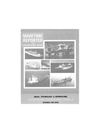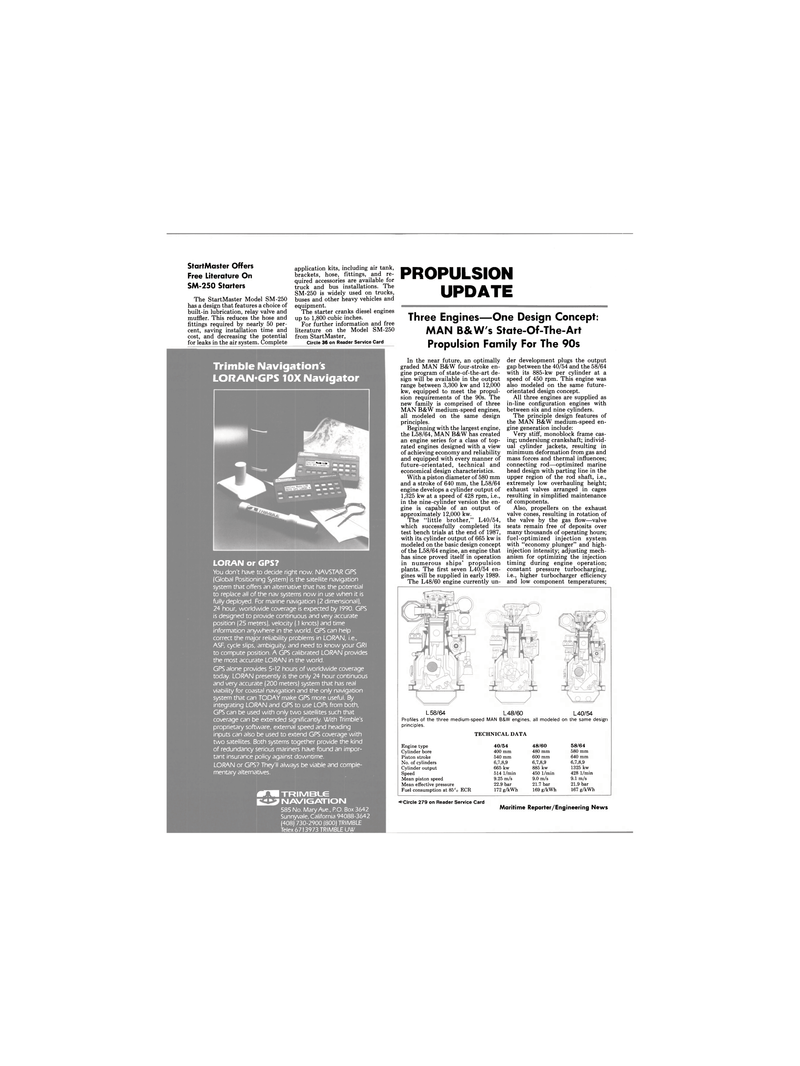
Page 6: of Maritime Reporter Magazine (December 1988)
Read this page in Pdf, Flash or Html5 edition of December 1988 Maritime Reporter Magazine
StartMaster Offers
Free Literature On
SM-250 Starters
The StartMaster Model SM-250 has a design that features a choice of built-in lubrication, relay valve and muffler. This reduces the hose and fittings required by nearly 50 per- cent, saving installation time and cost, and decreasing the potential for leaks in the air system. Complete application kits, including air tank, brackets, hose, fittings, and re- quired accessories are available for truck and bus installations. The
SM-250 is widely used on trucks, buses and other heavy vehicles and equipment.
The starter cranks diesel engines up to 1,800 cubic inches.
For further information and free literature on the Model SM-250 from StartMaster,
Circle 36 on Reader Service Card
PROPULSION
UPDATE
Three Engines—One Design Concept:
MAN B&W's State-Of-The-Art
Propulsion Family For The 90s
In the near future, an optimally graded MAN B&W four-stroke en- gine program of state-of-the-art de- sign will be available in the output range between 3,300 kw and 12,000 kw, equipped to meet the propul- sion requirements of the 90s. The new family is comprised of three
MAN B&W medium-speed engines, all modeled on the same design principles.
Beginning with the largest engine, the L58/64, MAN B&W has created an engine series for a class of top- rated engines designed with a view of achieving economy and reliability and equipped with every manner of future-orientated, technical and economical design characteristics.
With a piston diameter of 580 mm and a stroke of 640 mm, the L58/64 engine develops a cylinder output of 1,325 kw at a speed of 428 rpm, i.e., in the nine-cylinder version the en- gine is capable of an output of approximately 12,000 kw.
The "little brother," L40/54, which successfully completed its test bench trials at the end of 1987, with its cylinder output of 665 kw is modeled on the basic design concept of the L58/64 engine, an engine that has since proved itself in operation in numerous ships' propulsion plants. The first seven L40/54 en- gines will be supplied in early 1989.
The L48/60 engine currently un- der development plugs the output gap between the 40/54 and the 58/64 with its 885-kw per cylinder at a speed of 450 rpm. This engine was also modeled on the same future- orientated design concept.
All three engines are supplied as in-line configuration engines with between six and nine cylinders.
The principle design features of the MAN B&W medium-speed en- gine generation include:
Very stiff, monoblock frame cas- ing; underslung crankshaft; individ- ual cylinder jackets, resulting in minimum deformation from gas and mass forces and thermal influences; connecting rod—optimized marine head design with parting line in the upper region of the rod shaft, i.e., extremely low overhauling height; exhaust valves arranged in cages resulting in simplified maintenance of components.
Also, propellers on the exhaust valve cones, resulting in rotation of the valve by the gas flow—valve seats remain free of deposits over many thousands of operating hours; fuel-optimized injection system with "economy plunger" and high- injection intensity; adjusting mech- anism for optimizing the injection timing during engine operation; constant pressure turbocharging, i.e., higher turbocharger efficiency and low component temperatures;
L 58/64 L48/60 L 40/54
Profiles of the three medium-speed MAN B&W engines, all modeled on the same design principles.
TECHNICAL DATA
Engine type 40/54 48/60 58/64
Cylinder bore 400 mm 480 mm 580 mm
Piston stroke 540 mm 600 mm 640 mm
No. of cylinders 6,7,8,9 6,7,8,9 6,7,8,9
Cylinder output 665 kw 885 kw 1325 kw
Speed 514 1/min 450 1/min 428 1/min
Mean piston speed 9.25 m/s 9.0 m/s 9.1 m/s
Mean effective pressure 22.9 bar 21.7 bar 21.9 bar
Fuel consumption at 85 rc. ECR 172 g/kWh 169 g/kWh 167 g/kWh -^•Circle 279 on Reader Service Card 8 Maritime Reporter/Engineering News lYimble Navigation's
LORAN-GPS 10X Navigator
LORAN or GPS?
You don't have to decide right now. NAVSTAR GPS (Global Positioning System) is the satellite navigation system that offers an alternative that has the potential to replace all of the nav systems now in use when it is fully deployed. For marine navigation (2 dimensional), 24 hour, worldwide coverage is expected by 1990. GPS is designed to provide continuous and very accurate position (25 meters), velocity (.1 knots) and time information anywhere in the world. GPS can help correct the major reliability problems in LORAN, i.e.,
ASF, cycle slips, ambiguity, and need to know your GRI to compute position. A GPS calibrated LORAN provides the most accurate LORAN in the world.
GPS alone provides 5-12 hours of worldwide coverage today. LORAN presently is the only 24 hour continuous and very accurate (200 meters) system that has real viability for coastal navigation and the only navigation system that can TODAY make GPS more useful. By integrating LORAN and GPS to use LOPs from both,
GPS can be used with only two satellites such that coverage can be extended significantly. With Trimble's proprietary software, external speed and heading inputs can also be used to extend GPS coverage with two satellites. Both systems together provide the kind of redundancy serious mariners have found an impor- tant insurance policy against downtime.
LORAN or GPS? They'll always be viable and comple- mentary alternatives.
WTMI TRIMBLE
NAVIGATION 585 No. Mary Ave., P.O. Box 3642
Sunnyvale, California 94088-3642 (408) 730-2900 (800) TRIMBLE
Telex 6713973 TRIMBLE UW "«<*•' l OS

 5
5

 7
7
